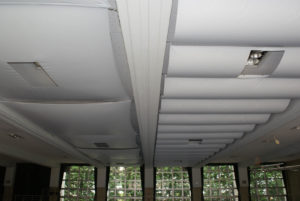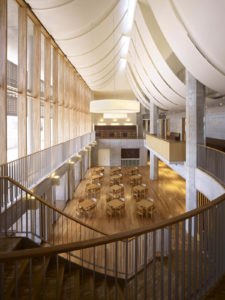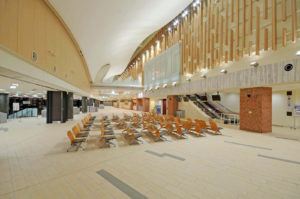
Fabric ceilings are gaining impetus in Japan after the Great Eastern Japan Earthquake in 2011.
In the October 2011 issue of Specialty Fabrics Review, the article “A safer ceiling” discussed the possible benefits of fabric ceilings to protect against damage from earthquakes, focusing on a case study at Miraikan Museum in Tokyo, which had sustained damage from the March 2011 earthquake and rebuilt with a new membrane ceiling. Ceilings often collapse during earthquakes and can cause serious damages, including injuries and casualties. The issue of earthquake safety has been seriously recognized by the Japanese government and the public since that time, and the impetus for safer ceilings is growing.
The Ministry of Land, Infrastructure, Transport and Tourism (MLIT) reviewed building codes after the Great Eastern Japan Earthquake and promulgated new legislation on suspended board ceilings that are more than 6 meters or higher from the ground, with an area exceeding 200 square meters. Ceilings of that size in public areas are required by law to have some seismic reinforcements, including using lightweight materials specified in several particular ways. The new laws took effect in April 2014.
In May 2013, the Ministry of Education sent out notice to local governments requiring them to improve aseismatic performance (mitigating the effects of earthquake shocks) of school gymnasium ceilings, which are often used as shelters when earthquakes occur. Improvements must be made by the end of March in 2016. If earthquake resistance has not been secured by then, ceilings that fail to comply may actually be required to be removed.
These new regulations are giving a strong push to fabric ceilings in Japan.

A gymnasium ceiling experiment
Mr. Sadao Izumi, chairman of the Japan Tent Sheet Manufacturers Association, says: “We, as an industry association, asserted to the government that there is no ceiling that never falls—but a fabric ceiling is the only ceiling that will never kill people even if it does fall. This is what our industry can contribute to society’s benefit, to help prevent damage from earthquakes; and also, this is a promising new market for us.”
Last year, with the goal of investigating fabric ceilings and their installation, 14 members of the Osaka Tent Sheet Manufacturers Association worked together and contributed money to develop two types of fabric ceilings, and installed them on an experimental basis in a gymnasium in Osaka. The group also managed to get a subsidy from the Osaka Prefectural Federation of Small Business Associations, as a manufacturing process innovation.
Mr. Nobuo Takeuchi, president of Yano Tent Co. Ltd., a member of the Osaka group, says, “This experiment is to show the Board of Education and others in the industry the advantages of the fabric ceiling as a solution for safer gymnasium ceilings, as mandated.” The two types of fabric ceilings used in the experiment are a suspension type and a tensioned type, both of which are much lighter in weight than gypsum board. Installation of each fabric ceiling requires only one day, less than half the time needed for the installation of a conventional suspended ceiling. It was confirmed that 10 kg of weight (an object falling from two meters above the ceiling) did not tear the ceiling fabric, in an experiment done at the Technology Research Institute of Osaka Prefecture. Takeuchi adds, “We had a lot of time to think about the design; but actually, the design is a combination of basic tent fabrication and nothing new, but which resulted in a unique, good-looking ceiling.”
Takeuchi says the fabric itself is not as expensive as other options; but most local governments have very limited budgets and very limited funds for putting new ceilings in the gymnasiums, and may consider simply removing the existing ceiling and not replacing it. “But, as this experiment was released in a newspaper, a railroad company, JR West, got very interested in the ceiling with respect to cost and safety,“ he says. The group’s effort has lead to a lot of public awareness and attention in various markets.
All the data related to the experimental fabric ceiling was provided to all members of the Tent Sheet Manufacturers Association throughout Japan, and member companies are proposing fabric ceilings based on the data, using their own ideas and designs. Mr. Atsuki Yamaguchi, president of Yamaguchi Sangyo Co. Ltd., says, “Especially for new buildings, fabric ceilings are drawing a lot of attention from the public.”

Possibilities and challenges
“The market for fabric ceilings is definitely expanding,” says Mr. Yuichi Murakami of Taiyo Kogyo Corp. “We have installed a number of ceilings, and most of the building owners are very concerned about safety now. A fabric ceiling is not only lightweight but also soft and yet strong, so it has several advantages compared to other options. Because of fabric’s softness, it has a high degree of freedom in form and enhanced designability. A fabric ceiling, if installed underneath the top light or windows, allows that natural light to be diffused and radiates indirect light to make the space under the ceiling much more comfortable.”
Basic functions of a ceiling include: hiding equipment and pipes right beneath the roof to offer a neat design; protecting against damage or injury caused by things falling from above; absorbing noise; and offering heat insulation. Ceilings can be removed in order to avoid collapse, but that leaves those buildings without all these valuable functions.
Murakami admits that reverberant sound can be a challenge for fabric ceilings, but adds, “By using a different type of fabric, to some extent the problem can be solved.” Another challenge is the heat insulation, Murakami says; as the fabric itself does not have good heat insulation performance, the fabric ceiling won’t offer the same level of insulating benefits of conventional materials. “But, the fabric ceiling is able to work as a divider of the space and heat insulator to some extent, compared to a ceiling without it. We are now collecting data about these points and doing further research.”
“We believe this safe ceiling concept is becoming more common in large buildings such as airports, arenas, gymnasiums and swimming pools, where the owner wants an attractive design in addition to functionality and performance,” says Murakami. “But there is also a need in smaller buildings, those that do not always require unique design, including offices, factories, shops and conference rooms, for example. Those buildings are much more numerous than larger structures. I believe the market size is infinite.”
Expanding ceiling functionality
“Safer ceiling” awareness, and the legislation by MLIT, have brought various new technologies and solutions to the market. Fabric ceilings are not the only options. Many companies are developing light and soft ceiling materials and/or methods that meet the requirements of the legislation and offer many performance advantages.
Karuten, developed by Tokyo-based Teijin Ltd., is one of those alternatives. Unlike a fabric ceiling, it is a lightweight board (about one-tenth the weight of gypsum board) made of polyester nonwoven fabric, V-Lap®, as a base material.
“This is a totally different concept from a membrane ceiling,” says Mr. Hideki Matsumoto of the engineering fibers department in Teijin’s High Performance Fibers Business Unit. “It creates the light, soft and safe ceiling. In addition, it allows very easy installation, cuts or screws easily, is lightweight but hard to break, and offers almost the same performance of heat insulation as a rock wool ceiling, with the same level of sound absorbency. “
A few weeks before this article was written, a major earthquake happened in Nepal. Earthquakes are an enduring threat in many countries, with the possibility of widespread damage and loss of life. And, of course, ceiling collapse can be caused by many natural disasters as well as manmade threats. Every building has ceilings; the “safe ceiling” concept is rapidly helping to create a new market for the specialty fabrics industry in Japan. Using fabric to help design and build safer structures, more resistant to earthquakes and other impacts, is a trend spreading around the world.
Ms. Kikuko Tagawa is executive director of IFAI Japan.
 TEXTILES.ORG
TEXTILES.ORG


